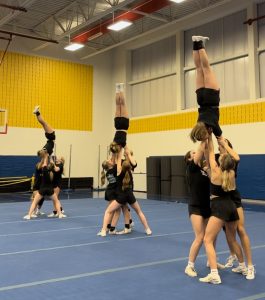Growing up my childhood consisted of one thing and one thing only- cheerleading. The past 13 years of my life I’ve spent numerous hours in practice, at games, and endured long competition days.
Those who understand cheerleading, know the physical and mental strength it takes for the sport. Others claim the activity is no more than shaking pom poms in their tight uniforms, not understanding what’s going on during the game.
Cheerleading is an athletic sport and should be viewed as more than just an activity. Just because most people don’t crowd around a TV to watch competitions, does not mean that it should be viewed as anything less than a highly competitive sport.
Competitive cheerleading is a combination of elite stunts, various tumbling, technical jumps, and continual movement.
The sport has grown tremendously over the past few years. The difficulty in stunting has made the sport difficult for some, and incredibly competitive for all.
Most of those who cheer on the sidelines at Friday night light games- that’s only the beginning of their season.
It begins during the summer for workouts and practices. We practice during the summer so we don’t lose to skills we worked hard to obtain during the past season.

Following the summer the season officially begins in early August to attend camps and mandatory practices. These camps and practices fill many hours in the day and require the ability to be able to try and learn new things.
The season then moves on to cheering Friday night lights at football games. Sounds easy right? Well, for the competition athletes this is most likely the hardest part of the season.
The beginning of the competition season is when the athletes are trying new stunts, acquiring new tumbling skills, and conditioning their bodies to be able to run a full out routine.
A full out routine is the most draining, demanding, and important aspect. This is what the athletes perform in a competition; it’s all the stunts, tumbling, and jumps put into a 2 minutes and 30 second routine. It is 150 seconds of non stop movement, constant lifting, and remembering to breathe of course.
Athletes need to properly prepare to run a full out and complete it. Just like any other sport, there needs to be vigorous training and conditioning.
Just like any of the sports Dallastown offers, there are opportunities for the athletes to tryout and compete at the collegiate level. This requires a high level of athleticism with stunting, jumping, and tumbling.
College cheerleaders at the D1 level perform stunts that no other program or team does. They have different rules and regulations that allow the teams to do the highest level or stunting possible.
So with all of these things in mind, why does cheerleading still get the short end of the stick when it comes to being called a sport? There is judgment in the hallways of those who cheer and call themselves athletes.
For me, cheerleading is a sport in which I could always improve on and I did strive to be the best I could be for my team.
We push each other through the hard times, and never give up on ourselves. We train all throughout the summer to prepare ourselves for the winter season of competing. We take and endure painful injuries in hopes to still compete for the team.
Cheerleading might be different from all of the known sports like football and basketball, but it takes the same amount of effort, courage, and grit as any other sport to be able to compete.
Cheer athletes are one of the strongest people I know; not just because they actually lift other human beings, but because they juggle the criticism that the world gives them about the sport they love.